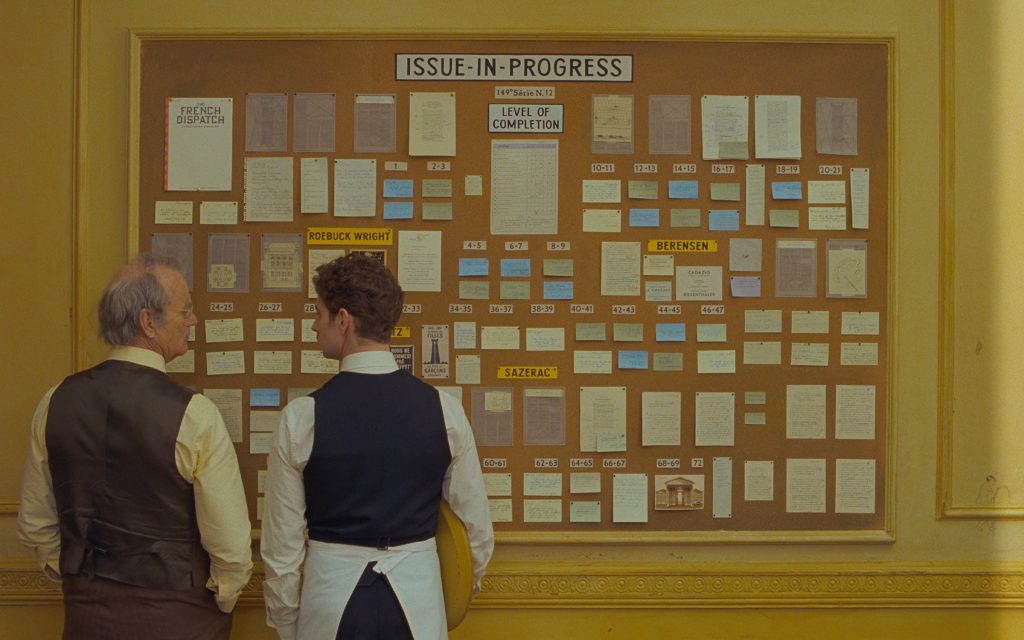Julia Cox ’23
Webmaster
The Oct. 22 release of Wes Anderson’s ninth film “The French Dispatch” was highly anticipated. The film made $1.3 million its opening weekend compared to a budget of $25 million, seeming to signal a revival of artistic films since the beginning of the pandemic. I personally was looking forward to the film — as a longtime fan of Anderson and his unique style, I was excited to see his latest work.
“The French Dispatch” was not what I expected. Though I was aware of the quirks and distinctiveness typically present in Anderson’s films, the storyline was unlike any I had seen before. The film tells the story of the literary magazine the French Dispatch, owned by a newspaper family in Kansas but published in France. The film begins by telling the audience that the founder of the Dispatch had passed away, and as part of his final requests, the magazine would be shut down. The audience is then taken through the final issue of the magazine and immersed visually into the stories of the Dispatch’s last issue: a bike tour of France and its dark underbelly, the story of an imprisoned artist and his lover, a saga featuring a young revolutionary and chess fanatic, and a story-within-a-story of an author’s novel which details the riveting case of a kidnapping. The film then reveals what happens to the Dispatch and its contributors.
I did not expect the film to be laid out as such. Though Anderson’s storytelling has always been unique — as seen in the convoluted story of “The Grand Budapest Hotel” — “The French Dispatch” was singularly creative. The unpredictability of the storyline led me to struggle a bit when analyzing the plot. However, Anderson incorporated many creative artistic choices that pointed to his intentions as writer and director.
One interesting device utilized by Anderson was color. Often taken for granted by audiences, Anderson chose to use color film more sparingly than most. In the three primary stories the film takes you through of the artist, activist, and author, Anderson opted to only use color during very precise instances, most often to highlight important items such as the artist’s prized painting or the purple of a poison elixir. Additionally, the Dispatch office was always in color, likely to ground the audience back in the “reality” of the story.
The film also played with camera work. In previous films, Anderson used aspect ratios of film to convey different locations or time periods. Aspect ratios, which convey the length and height of a projection, typically stay constant not only in films but between different movies as well. However, in “The French Dispatch,” Anderson used primarily a smaller aspect ratio while occasionally employing the larger, standard ratio to accentuate particular scenes. Perhaps more uniquely, Anderson would also shoot scenes in a kind of mock freeze-frame style. The actors would stand still mid-movement — though you could still see them breathing and moving slightly, which was without a doubt intentional — while the camera would pan out to an angle showing multiple people in the midst of a busy situation. This perspective made the frame then seem like a work of art, with the actors imposed in a vibrant environment.
“The French Dispatch” is playfully morbid and toys with themes of love in dark places and imperfect perfection, as the carefully curated aspects of Anderson’s stylistic decisions contrast with the mistakes and downfalls of characters. Overall, I found the film to be unpredictable in a way that wasn’t sloppy or annoying, but exciting and original. I’d recommend this film to any Anderson fans hoping to see another clean, smart, and creative film — “The French Dispatch” doesn’t disappoint.
Image Source: Texas Monthly



